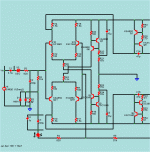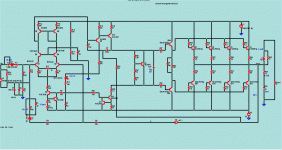Hey ther...i'm new here....I'm a student in electrical engineering at college....i'm looking for a schema to do a 4 channel x 100w RMS for my car speaker....2 stereo IN...and 4 OUT
THANKS
Anthony
THANKS
Anthony
I guess your not allowed to just go an buy a 4x100w caramp.
Maybe the quasi amp for beginners by apex audio x4 would suffice.
Maybe the quasi amp for beginners by apex audio x4 would suffice.
What supply voltage does it have to run from?
What impedance are the speakers?
Do they need to be real Watts of output or would any old PMPO power output do?
What impedance are the speakers?
Do they need to be real Watts of output or would any old PMPO power output do?
A 12Vdc supply will allow a maximum of ~+-5Vpk into your 4ohm load.
This is equivalent to ~3W into 4ohm.
If you build a balanced or bridged amplifier using the 12Vdc supply you may get 6W into 2ohm from one half of the amplifier. When bridged/balanced you can expect 12W into 4ohm speaker.
You now need 8channels of amplification each capable of 6W into 2ohms (reactive speaker) to get 4channels of 12W maximum power output.
Do you see a problem?
Maybe the purpose of the project is to recognise that the target is impossible to attain from a 12Vdc supply.
Guess where your research will take you next?
This is equivalent to ~3W into 4ohm.
If you build a balanced or bridged amplifier using the 12Vdc supply you may get 6W into 2ohm from one half of the amplifier. When bridged/balanced you can expect 12W into 4ohm speaker.
You now need 8channels of amplification each capable of 6W into 2ohms (reactive speaker) to get 4channels of 12W maximum power output.
Do you see a problem?
Maybe the purpose of the project is to recognise that the target is impossible to attain from a 12Vdc supply.
Guess where your research will take you next?
Yeah I know...but its 12V from my car battery...but there will be a powersupply to get higher voltage input !....
Real watts !!
4 ohms speaker
12V supply as it will be in a car !
For real watts , you need a switching power supply (12V to +/- 40-50V).. this is typical of most analog OEM multichannel "blasters". The amps are typically LIN topology 1 or 2 output pair pair class AB.
OS
SMPS!Guess where your research will take you next?
My brother is an electrical engineer, and he develops SMPS to any specs (in the US!).
You are going to enter a very nice road, full of curves and challenges!
Good luck!
For real watts , you need a switching power supply (12V to +/- 40-50V).. this is typical of most analog OEM multichannel "blasters". The amps are typically LIN topology 1 or 2 output pair pair class AB.
OS
I dont mind of input voltage !
I would just like to have an amp with 2 stereo in...so 4 output channel...of 75-100rms power output....
what do you mean by : LIN topology ?
I dont mind of input voltage !
I would just like to have an amp with 2 stereo in...so 4 output channel...of 75-100rms power output....
what do you mean by : LIN topology ?
Like the dozens of Pyramid gold 100W X4 amps I have repaired , "LIN" is a typical car linear stereo amp design (below 1) , I have seen fully balanced designs , too.
(below 2).
Add 4 of these to a hefty switching supply (SMPS) and you have your 4-channel "blaster" 😀
OS
Attachments
do you have other example.....other schema....
http://69.138.150.33/WEBSITE/PDF1/Electronics/Projects/Audio_amp/
hundreds....
A Watt is defined by passing 1Ampere of current through 1ohm of resistance. This happens to require 1volt of potential to drive this "circuit".
If one wants to use AC instead of DC to power the circuit, then the definition is altered to show AC current:
A Watt is defined by passing 1ampere rms of current through 1ohm of resistance. This happens to require 1Volt rms of potential to drive this "circuit".
Note, in neither definition is Peak watt nor RMS watt used.
Watt is the unit of Power named after the Scottish Engineer James Watt. As such it always uses a capital W
rms = root mean squared. It's a measure of the equivalent heating power of the current that exactly equals that given by the same value of DC current.
If one wants to use AC instead of DC to power the circuit, then the definition is altered to show AC current:
A Watt is defined by passing 1ampere rms of current through 1ohm of resistance. This happens to require 1Volt rms of potential to drive this "circuit".
Note, in neither definition is Peak watt nor RMS watt used.
Watt is the unit of Power named after the Scottish Engineer James Watt. As such it always uses a capital W
rms = root mean squared. It's a measure of the equivalent heating power of the current that exactly equals that given by the same value of DC current.
- Status
- Not open for further replies.
- Home
- Amplifiers
- Solid State
- Looking for 4 channel x 100w RMS amp schema


